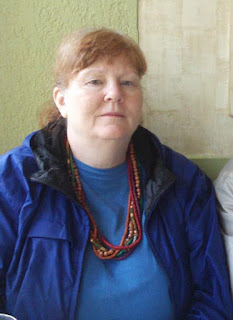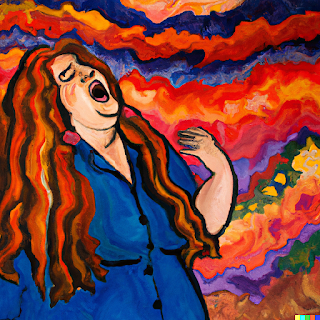Fat Woman Fasting: Intermittent Fasting -- Yea or Nay?
 |
| The author at George Takei's book signing NCTE: November 2019 ________________________ |
After the holidays,
it was time to get serious.
My weight was going up – fast.
For two years, WW had worked well for me, but then it just stopped working – no matter how much I
stuck to the program, my weight just wouldn’t budge.
The least deviation from program resulted in weight gain.
I was discouraged.
To add insult: last summer, while on vacation, I gained 11 pounds in two
weeks. Granted, I wasn’t sticking to program very well, but that amount of gain
seemed excessive – like 10,000 calories-a-day gain.
I knew that couldn’t be right. I was eating nowhere near that number.
After vacation, I could not shake that weight. Here and there, I would
lose a pound or two, but then I would eat something high calorie and high fat,
and the weight would just come back – and then some.
I had my thyroid checked –
Normal.
So I just kind of gave up.
Hell. I gave up.
Then, the holidays – the bane of any program, weight-loss or even maintenance.
Thanksgiving and the Christmas holidays were especially brutal last year
(2019) – I attacked food like a shark (no excuses).
My clothes barely fit, my body uncomfortable.
Christmas Day, I was a veritable eating machine. Perhaps I did hit that 10,000
calories mile mark – three huge meals, all fatty, carb-filled, and sugary.
On Christmas night, I paid the price – my esophagus was afire.
Had I been a dragon, I could have blown fire. I was in so much pain I
could not sleep.
The next day, I felt horrid, chicken noodle soup and crackers the only foods
I could eat.
Something had to be done.
My weight and health were spiraling out of control.
Should I make another appointment with my doctor?
No, I was too embarrassed.
I know, I know, that’s a stupid excuse. My doctor, I’m sure, has seen it
all.
Still, I had done fairly well for the past three years, but I was now “the
bad patient” who turned out to be a major disappointment, the success story turned
sour.
More alarming, I sensed a familiar arc in my dieting history: after
working so hard to get my weight down, I was again on the upward tick.
If I continued on this track, I would be back to 200 pounds within a year
or two.
Then just after Christmas. I read a newspaper article about “intermittent
fasting” (IF), which has been trending since 2017 (I never got the memo – at
that time, I was succeeding on WW, so it’s not surprising that it missed my
radar).
Fasting? Are you serious?
I kept thinking about “The Golden Hour” diet I tried years ago.
Basically, for one hour each day, a dieter could eat whatever she wanted. The
other 23 hours were draconian, though, consisting of thin broths and liquids.
It was a terrible idea for someone who could pack in quite a bit of food in an
hour.
Obviously, the Golden Hour was a disaster.
But I kept an open mind about IF.
After doing some research, I decided to give it a shot – nothing to lose
(except those stubborn 25 pounds).
For support, I joined an IF group on Facebook, just lurking for now.
There is some good science behind fasting on a limited basis. This
comment from “Intermittent Fasting – Surprising Update,” by Monique Tello,
M.P.H., M.D. (The Harvard Health Blog), caught my attention:
“We have evolved to be in sync with the day/night cycle, i.e., a circadian
rhythm. Our metabolism has adapted to daytime food, nighttime sleep. Nighttime
eating is well associated with a higher risk of obesity, as well as Diabetes.”
Hello! I’m that nighttime eater!
If I could train myself not to eat after 7:00 or 8:00 p.m. (I’m a confirmed
night owl; this means at least five hours of no eating before going to bed),
perhaps I could train myself not to be hungry at night. It seems that even
healthy food late at night can mess up one’s metabolism, and turn to fat,
possibly resulting in type 2 diabetes – and a shorter life.
I started on December 27, 2019 (although I took New Year’s Eve and Day
off. More on this later.)
As of this writing, it is now mid-February – not too bad so far, but
there are some caveats, which I’ll address later.
Most of the intermittent fasting occurs overnight: stop eating early in
the evening and start eating later in the day, effectively fasting 14-18 hours in
a 24-hour period.
Skipping breakfast? Isn’t that heresy? Doesn’t that go against every healthy
eating plan ever created?
Not really. It’s just eating breakfast later in the day and ending dinner
and snack earlier. I’m still eating three meals a day and a snack (sometimes two)
but they are smaller and closer together.
My sweet spot seems to be between 14 and 15 hours, although I have done
16-18 hours as well.
Straightforward enough.
I have opted
for the 5:2 program:
– Five days eating Weight
Watchers SmartPoints (evidently, revived as one of three WW options and the program before Freestyle,
an unmitigated disaster for me) and
– Two days of partial
fasting, 500 - 600 calories. At first, I was dubious about the restricted calorie
days. I once went on an 800 calorie-a-day diet; it was grueling and unpleasant,
and, of course, I couldn’t stick to it long term, so this aspect really scared
me, still scares me a bit. As of this writing, I have experienced several fast
days. Surprisingly, I have not felt that haunting hunger associated with
restricted calorie intake – perhaps because I don’t do the restricted fast two
days in a row.
I’m starting small, generally keeping my fasting hours to 14 hours
(although once I was able to stretch the fast for 18 hours – not recommended).
In fact, the experts believe that senior citizens should limit their overnight
fast to 14-15 hours, and people with medical conditions, such as Type 1 Diabetes,
should probably consult a doctor before embarking on this regimen.
My weight-loss plan has not changed dramatically: five days of the week, I
follow WW’s SmartPoints program. For various reasons, I have decided not to return to WW itself, discussed in another article, but the program itself is sound, healthy, and realistic.
On the partial fast days, I thought I would be ravenous, but,
surprisingly, I am not. I am doing two things right: I stay hydrated with
caffeine-free herbal tea and coffee and Hydrant, a drink
mix with minerals, and I concentrate on lean proteins, for example, white-meat
chicken, Built Bars,
and lo-cal non-starchy vegetables (carrots, asparagus, and cauliflower).
Sample food journal for partial fasts (500-600 calories):
Breakfast (11:30 a.m., after a
15.5 hour overnight fast):
·
1/2 cup of Egg Beaters with shredded non-fat
cheese: 85 calories (1 point)
·
Multi-grain Pop Cake: 16 calories (0 points)
·
Decaffeinated version of Hydrant mix with sugar-free
cherry drink (I drank this throughout the day): 30 calories (0 points)
Lunch (3:15 p.m.):
·
Built Bar: 110 calories (3 points)
·
Lettuce: 10 calories (0 points)
Dinner (6:30 p.m.):
·
Chicken, carrot, onion flakes, and cauliflower
in soup base: 160 calories (1 point)
Snack (7:30 p.m.)
·
Built Bar: 110 calories (3 points)
Total
Calories and points: 521 (8 points)
Hydrant Reviews ( I recommend the caffeine-free version.)
I’m not ready to do my own Hydrant review
yet; I have only used it about 10 times, but my daughter-in-law swears by it.
I suppose I could have blown my 500 - 600 calories on an ice cream
sundae, but I suspect I would have been hungry all day 😊
My takeaway so far: Intermittent Fasting effectively cuts down snacking,
even on “healthy” foods. “Intermittent Fasting: Surprising Update” explains the science behind limited fasting.
The best side effects: my appetite has been cut by about two-thirds, and
I’m experiencing fewer digestive problems – no more fiery esophagus. So far, no
gnawing hunger at night, and the urge to eat is about nil. This surprised me
because I thought I’d be fighting hunger – at least at first – and I’m not.
Don’t get me wrong: if I see a big juicy burger and French fires advertised
on TV, yeah, I might experience a growl or two, but I don’t experience that
overwhelming desire to grab compensatory snacks because of it.
Three negative side effects: some sleep disruption; some tiredness; some
intermittent wobbliness; at first, leg cramps upon awakening (but this soon
went away). For the wobbliness, I drink 1/4 of a Premier Protein. If the cramps
return, I may have to add to my supplements.
For the tiredness: I need to turn off the screens at night and get more
sleep.
My research has shown that the negative side effects will go away as the body
adjusts to the new regimen.
I don’t anticipate stretching the fast time to the upper limit of 18
hours – that seems extreme – nor will I participate in 24-hour fasts. The two-day-a-week
restrictive eating plan (500-600 calories) is enough. With Built Bars and
Premier Protein, the 5:2 plan seems to be very doable. With such restrictive calories,
the nutrition matters a lot.
The one-meal-a-day (OMAD) plan just plain sounds crazy to this old gal, so that won’t be an option. The snake-juice version just sounds all and out kooky – so it’s a
no-go there.
Some caveats I see going forward: I have yet to be tested on a holiday, multi-day
conference, or vacation.
How will this work then?
I have a plan for that. Fortunately, I have gone out to eat several times
since starting IF, and I did just fine, so going out to eat is not a huge impediment.
It’s a matter of making the right choices, just as one does on a regular eating
plan.
My plan for disruptive times: for a single holiday or important social
event, I will give myself a little slack on treats, but I will stick to IF (stopping
at 7:00 - 8:00 p.m. and not breaking the fast until 9:00 or 10:00 a.m. If I
find myself eating later in the evening, I will move next day’s breakfast up
later).
As I noted earlier, I took off New Year’s Eve and Day off, only five days
into IF. I believe this is key for IF success; we must be flexible in life
because there will always be some holiday or event that will throw a kink into
our best-laid plans and good intentions. We spent New Year’s Eve and Day with
friends, and it was later in the evening when we ate dinner, plus desserts and other
goodies were available. Keeping to program is what I need to do day to day, not
depriving myself of the occasional treat.
For conferences, I will limit treats to the main conference meal, and
bring my protein bars and beef jerky with me for breakfasts and small meals. I
will place partial fasting days on hiatus and do the fast on the day I return
home. Three vacations are upcoming: a three-week trip to Florida, a three-week
trip overseas, and a two-week trip to Iowa (which tends to be full of triggers –
another issue). For the overseas trip, I will also place partial fasting on hiatus
but still do IF. On the other two trips, I will do IF and try to do partial
fasting on a limited basis.
In other words, I’ll forgive myself if I can’t manage the partial fast on
vacation.
I thought that giving up some of my night snacks would be difficult, but
I have discovered that by having an evening cutoff time for eating forces me to
make better food choices and eat some of the same healthy snacks earlier in the
day. Also, when that clock hand reaches the cutoff time, something seems to “click”
in my head, and I don’t really crave anything else.
I have yet to experience that gnawing hunger I expected; I can’t tell if
this reaction is psychological or physical – I’m definitely in the zone mentally,
but, if this is just mental fortitude, will I be able to sustain this in the long
term?
I hope so.
This could end up being a lifestyle change, not just another diet.
It’s only been six weeks, though.
Check back with me in a year!








Comments